 |
 |
 |
| | Home | People behind the Scenes | Richard Emmert | The Richly Varied World of English Noh |
| |
|
|
![]() Back to Richard Emmert Interview
Back to Richard Emmert Interview
After performing the role of the shite in St. Francis while in college, Richard Emmert became involved in the writing and production of a number of English Noh plays. Here, we introduce the story lines of those English Noh plays.

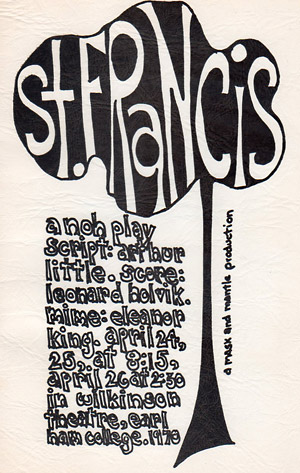 |
Program from the 1970 performance of St. Francis at Earlham College |
St. Francis (1970)
Text: Arthur Little
Music: Leonard Holvik
1970 first performed at Earlham College, Shite: Richard Emmert
1975 performed in Tokyo, Director: Don Kenny, Musical Director: Richard Emmert, Choreography: Akira Matsui (Kita school)
1988 Student performance at Earlham College, Musical Adaptation: Richard Emmert, Directors: Richard Emmert, Akira Matsui
Story: A travelling Quaker (waki) encounters an old man (shite) on the impoverished streets of Calcutta. While the traveler is speaking with the old man, he sees that he is full of compassion towards all living things and has a holy nature as if he was St. Francis of Assisi himself. The old man leaves but later returns in his true form as the spirit of St. Francis. He describes how he led a life of pleasure in his youth, but then gave it up to live for the poor. He then dances the dance of a saint.
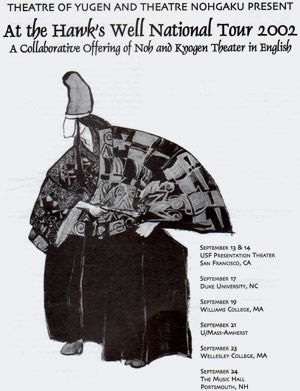 |
Program from At the Hawk’s Well from the 2002 US tour of Theatre Nohgaku |
At the Hawk's Well (1916/1981)
Text: William Butler Yeats
Music and Noh Adaptation (1981): Richard Emmert
1916 First performed in London
1981 Performed in Kyoto and Osaka as English Noh (NOHO Troup), Director: Jonah Salz, Musical Director: Richard Emmert
1982 Tokyo performance by NOHO, Director: Richard Emmert
1984, 1985, 1990 Performed in Japan (NOHO) and Australia (University of Sydney), Direction: Variously by Richard Emmert, Akira Matsui, Jonah Salz
2002 US Tour by Theatre Nohgaku (eight performances, seven venues), Direction: Richard Emmert, Hawk woman: Akira Matsui
Story: A young man, Cuchulain (an Irish mythological hero), seeking a well whose waters confer immortality, finds the well beside which is an old man who has been by the well 50 years waiting for the waters to flow. Nearby, a woman possessed by the spirit of a hawk guards the well. When the waters begin to flow, the spirit of the hawk dances, putting the old man to sleep and enticing the young hero away so neither is able to drink of the water. The young man decides to leave to seek other adventures leaving alone the old man, who has wasted his entire life by the well all for naught.
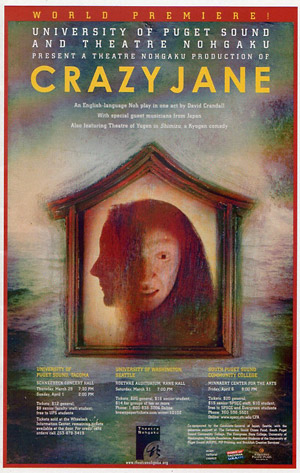 |
Program from the 2007 performance of Crazy Jane |
Crazy Jane (1983/2002)
Text, Music, Direction: David Crandall
1983 First performed in Tokyo with Western instruments and Noh choreography
2002 Rearrangement of the music in Noh style by David Crandall
2007 US Pacific Northwest tour by Theatre Nohgaku
Story: A young man on a journey comes to a church in a seaside village where he encounters a deranged woman named Jane who has been wandering the countryside in search of her former lover Tom. Though the young man denies it, Jane is convinced that he is Tom. Jane speaks of her memories of dancing with Tom and entices the young man to dance with her. While dancing, she disappears, and the young man now appears to be the crazed one.
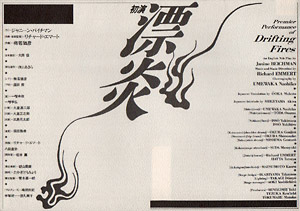 |
Program from the first performance of Drifting Fires in 1985 at the Tsukuba Expo |
Drifting Fires (1985)
Text: Janine Beichman
Music/Direction: Richard Emmert
Choreography: Naohiko Umewaka
1985 First performed at the Tsukuba Expo, Shite: Naohiko Umewaka (Kanze School)
1986 Performed at the main hall of Zojo-ji, Shite: Naohiko Umewaka (Kanze School)
Story: After the natural destruction of the planet earth, travelers from the Veil Nebula visit its remains. There, an old woman appears out of the remaining flames. She reveals that she is the ghost of the last human being on earth, then disappears. In the second half, she again returns, and through the power of love and memory, dances in remembrance of the beauty of the earth that has been lost, then disappears into the void.
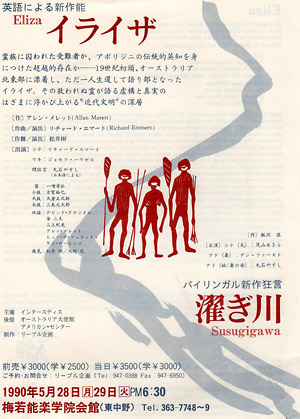 |
Pamphlet for the 1990 performance of Eliza at the Umewaka Noh Theatre in Tokyo |
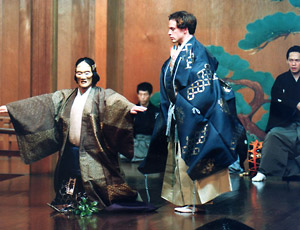 |
1990 Eliza performance at the Umewaka Noh Theatre in Tokyo
Photo : Kita School Photo by Abiko |
Eliza (1985)
Text: Allan Marett
Music/Direction: Richard Emmert
Choreography/Direction: Richard Emmert
1989 Performed by students of the University of Sydney, Direction: Richard Emmert, Akira Matsui
1990 Performed at the Umewaka Noh Theatre in Tokyo, Shite: Richard Emmert
Story: A traveler to Fraser Island in Australia meets an old woman who tells the story of Eliza Fraser, the wife of the captain of a ship shipwrecked years ago. The woman begins to tell fantastic stories about Eliza’s experiences and how these were used to satisfy the beliefs of white society. The traveler questions her story full of exaggeration and in so doing the woman’s true nature as the spirit of Eliza is set free. The spirit then reappears and dances in an aboriginal festival as she relives her experiences of aboriginal culture and the truth of her harmonious stay with aboriginal peoples.
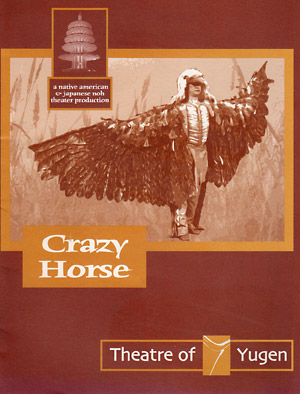 |
Program from the 2001 performance of Crazy Horse in San Francisco |
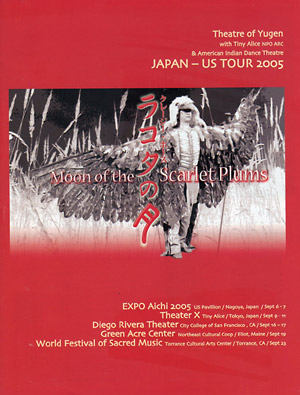 |
Program from the 2005 performance of Moon of the Scarlet Plums |
Crazy Horse/Moon of the Scarlet Plums (2001)
Text: Erik Ehn
Music: Richard Emmert
Direction: Yuriko Doi, Theatre of Yugen
2001 First performed under the name Crazy Horse in Japan Town, San Francisco by Theatre of Yugen, Shite: Masashi Nomura, Nohkan: Richard Emmert
2005 Remounted by Theatre of Yugen as Moon of the Scarlet Plums at the Aichi Expo, Tokyo Theatre X and three venues in the United States, Shite: Masashi Nomura (Kanze School), Nohkan: Richard Emmert
Story: A young Native American woman receives a message in a dream during a powwow and decides to set out on a journey. Deep in the desert, her car breaks down. The mechanic who visits her turns out to be the ghost of the 19th century Oglala Lakota Indian warrior, Crazy Horse, who invites her to look for a lost flute. The spirit dances and prays for peace as the woman in turn begins to think about her own identity and culture.
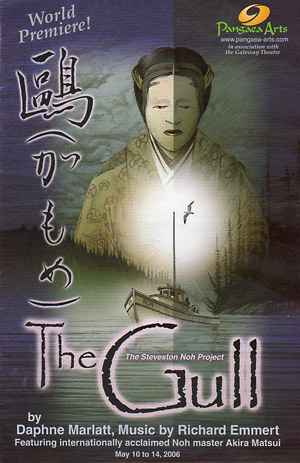 |
Program from the production of The Gullin 2006 |
The Gull (2001)
Text: Daphne Marlatt
Music/Direction: Richard Emmert
Choreography/Direction: Akira Matsui
2006 Performed in a tent by Richmond City Hall, a suburb of Vancouver, Canada by Pangaea Arts, Shite: Akira Matsui, Chorus leader: Richard Emmert
Story: During World War II, a Japanese-Canadian fisherman and his family is placed in an internment camp inland. The father dies under forced labor, then after the war, the mother, though hoping to return with her sons to her native Japan, also dies of disease. Their two sons, now grown, are finally allowed to return to the Pacific coast to fish, and when they depart on their first fishing trip up the coast, they encounter a mysterious seagull who seems to speak in the broken English of their mother. The woman tells a story similar to the fate of the brothers’ mother, then flies away. In the second half, the spirit of the brothers’ mother appears, lamenting her fate of having been unable to return to her Japanese home. The brothers try to convince the spirit that their home is different from hers. When they hear the sound of the bells and buoys, the spirit recalls her father’s temple and realizes that her world is connected across oceans and cultures. She is enlightened and her spirit freed.
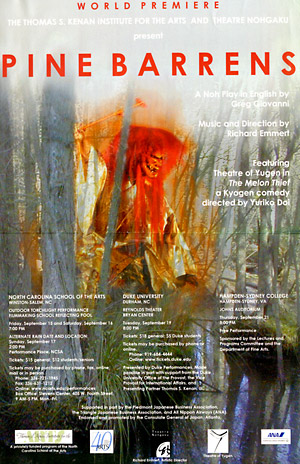 |
Poster from the 2006 production of Pine Barrens by Theatre Nohgaku |
Pine Barrens (2006)
Text: Greg Giovanni
Music/Direction: Richard Emmert
2006 Performed as part of the US tour of Theatre Nohgaku, Shite: Richard Emmert
Story: Two witches go looking for their missing colleagues in the swamp-like pine barrens of New Jersey. They meet a young boy who relates the story of an unwanted 13th son of a Mrs. Leeds who gave that son to the devil and himself became a demon. The young boy warns the witches of that demon now residing in the swamp. In the second half, the Jersey devil appears forcing the witches to use all their powers to fight the devil and drive it off.
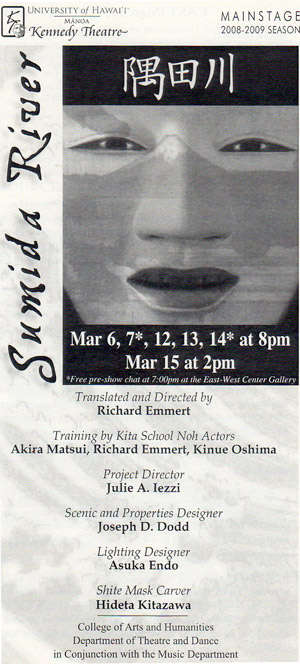 |
Program from the 2009 University of Hawaii production of Sumidagawa |
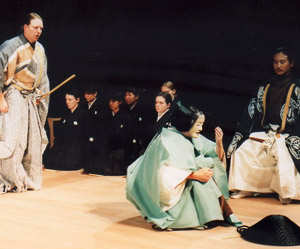 |
2009 Sumidagawa performance at the University of Hawaii
Photo provided by Richard Emmert |
Sumida River (2009)
English version of the classic Noh play, Sumidagawa
Performance translation/Musical arrangement/Direction: Richard Emmert
2009 Performed by students of the University of Hawaii as the culmination of a year-long Noh project. Project teachers: Akira Matsui and Kinue Oshima (Kita school)
![]() Click here for the story of the classic play Sumidagawa
Click here for the story of the classic play Sumidagawa
 |
2009 Joint production of Pagoda staged in Europe by the Oshima Noh Theatre and Theatre Nohgaku Photo: Clive Barda |
Pagoda (2009)
Text: Jannette Cheong
Music/Direction: Richard Emmert
Choreography: Kinue Oshima, Teruhisa Oshima
2009 Joint production in Europe of Theatre Nohgaku with the Oshima Noh Theatre of the Kita School, Shite: Kinue Oshima
Story: A young English woman of Chinese descent travels to the humble village of her dead father in southeast China. There, at a Buddhist pagoda, she encounters a mother with her daughter who long ago had sent off a young son to work on a ship to protect him from famine. After climbing the pagoda and looking to sea waiting for their son/brother to return, the women disappear. The traveller then meets a fisherman who tells her the legend of the pagoda and the story of a woman who had sent her son to sea. The English woman realizes that the two women she had encountered earlier were in fact the spirits of her grandmother and aunt and her father was the son they were waiting for. Later, the spirits reappear and tell of their past hardship, before dancing a dance of reunion. The traveller realizes that her family are now reunited in the spirit world as she contemplates the fates of those separated from their homeland.
![]() Back to Richard Emmert Interview
Back to Richard Emmert Interview
| Terms of Use | Contact Us | Link to us |
Copyright©
2026
the-NOH.com All right reserved.